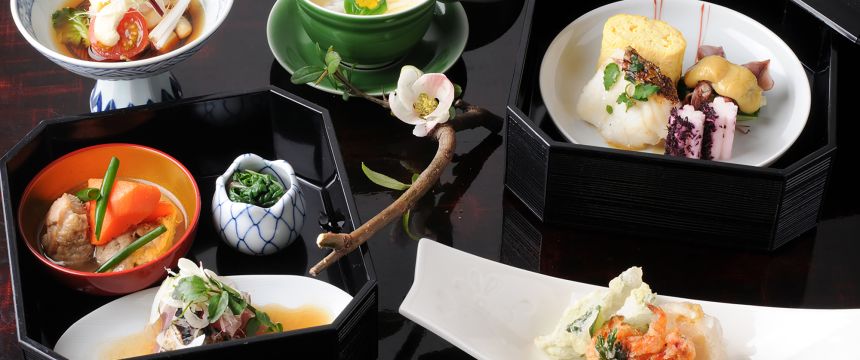Osaka City, Osaka Prefecture - Kansai
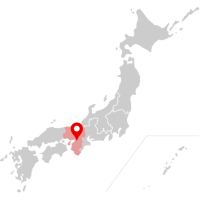
The nation’s second-largest city, Osaka, is known colloquially as “Japan’s kitchen,” thanks to its amazingly diverse culinary tradition. And no visit to the country is complete without a gastronomic tour of the area. Even a single trip can send you home with a solid foundation in the basics of preparing your own authentic, down-to-earth Japanese soul food.
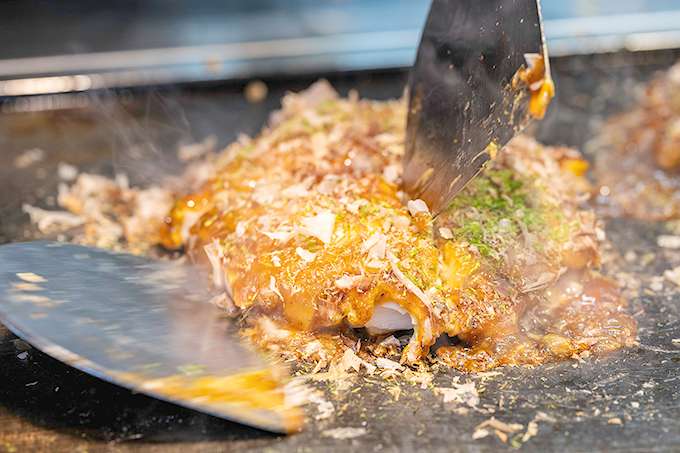
Two dishes best characterize the city: okonomiyaki and takoyaki. Both are loved by locals for their bold, rich taste and are surprisingly easy to make at home.
The Osaka Difference
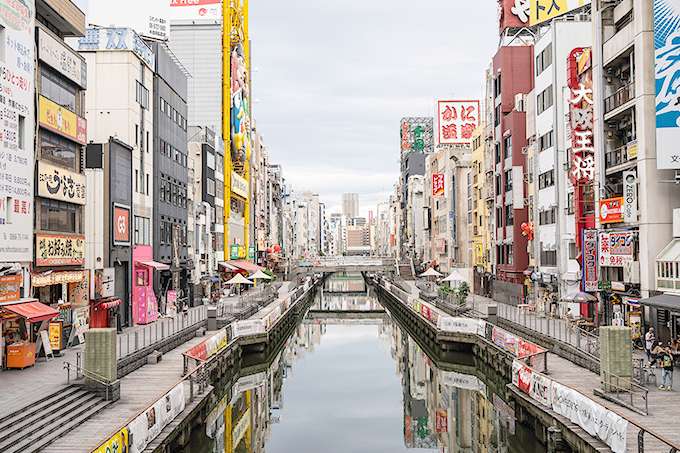
The first port of call for most travelers to the Kansai region of western Japan is usually Kyoto, which is known for a subtle and refined cuisine befitting its role as the old capital. If anything, Osaka is the polar opposite: brash, rich, and unashamed. Everyone who visits will find the city’s no-nonsense, down-to-earth attitude infectious. Paired, as this is, with a warmth and sense of humor that doesn’t take itself too seriously, it’s no wonder that Osaka is Japan’s stand-up comedy capital.
This character manifests itself in the food culture, with countless restaurants and stalls jostling for attention with ever-more-extravagant signs coaxing customers inside. Okonomiyaki and takoyaki are much the same, made with flair and delivering an ever-escalating series of flavors. While both are the culmination of long history, in their current form they are relative newcomers to Japan’s centuries-old culinary scene, having emerged in the city in the 1930s.
Heading Downtown
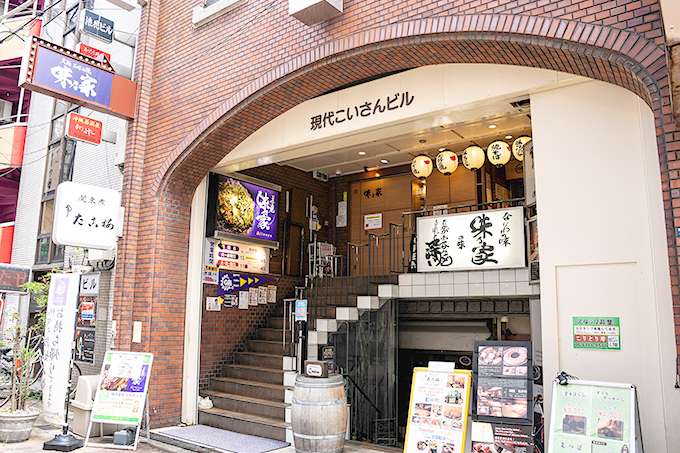
Given that it’s a local specialty, finding an okonomiyaki shop in Osaka will not pose a challenge. But if you’re looking for a place that really takes their okonomiyaki seriously—and dishes out some warm Osaka hospitality on the side—four-generation family business Ajinoya is a great place to start.
Founded in 1965, Ajinoya has built their reputation on a recipe that calls for generous amounts of cabbage and relatively little batter, ensuring a light, fluffy texture. This, plus their blend of karashi (mustard) and signature savory sauce that combines tomato and apple for a hint of sweetness, has won them countless fans and, more recently, a Michelin Bib Gourmand ranking.
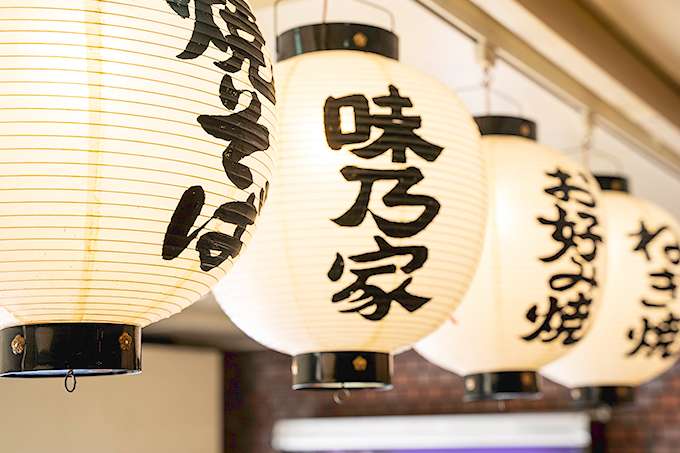
The main store is a short walk from Namba Station in Osaka’s colorful Dotonbori shopping and dining district. Head up the stairs to the second floor, step inside, and take a seat at one of the tables equipped with a large metal grill on which the chefs cook the okonomiyaki before your eyes. Ordering is easy, thanks to a multilingual menu available in English, Japanese, Chinese, and Korean.
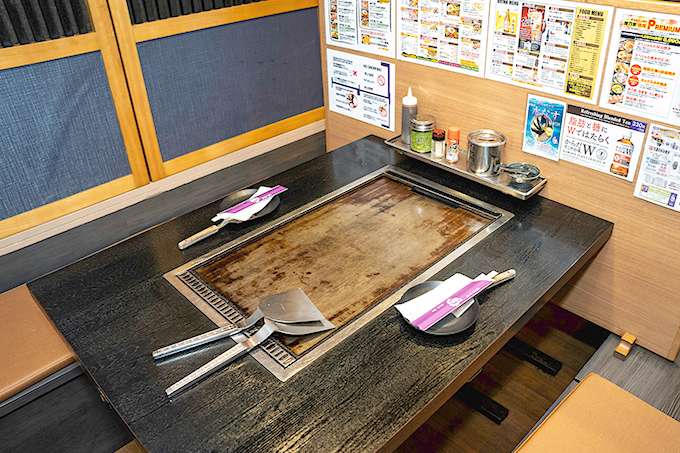
Improvised Menu
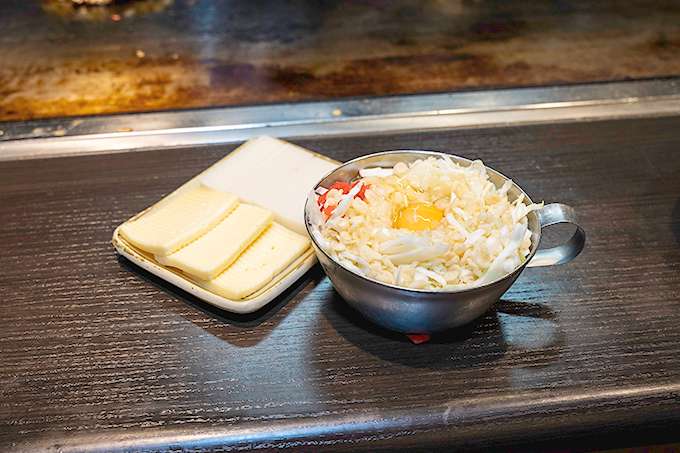
Literally meaning “as you like it,” okonomiyaki began as a practical way of conjuring up a meal with whatever ingredients were on hand. Cabbage, eggs, dashi (broth), and flour form the basic ingredients of the batter, while yamaimo (mountain yam), tenkasu (tempura crumbs), green onions, and beni shoga (red pickled ginger) are typically added.
Toss some meat or seafood into the mix, grill both sides, then douse with savory okonomiyaki sauce, tangy mayonnaise, fragrant aonori (seaweed) flakes, and delicate katsuobushi (skipjack shavings). The result is a splendid dish that’s nutritious, filling, and inexpensive. It hits the guilty pleasure mark and is surprisingly light at the same time!
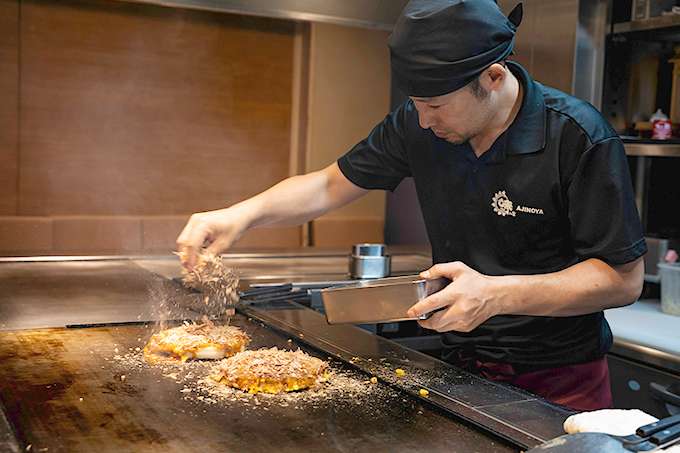
It should also be noted that, while the Kansai-style okonomiyaki popularized in Osaka is the most common variation found across the nation, there is also a Hiroshima style, in which a fried egg, as well as yakisoba or udon noodles, are added, and the ingredients are layered instead of mixed. Friendly Osaka–Hiroshima rivalry notwithstanding, Ajinoya includes Hiroshima-style okonomiyaki on their menu alongside the local favorite.
Beyond Okonomiyaki
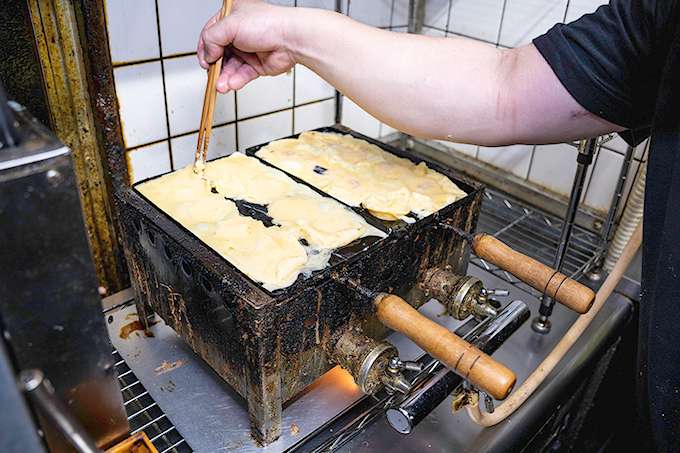
Sharing many of the same ingredients is takoyaki—bits of boiled octopus wrapped in batter and cooked up as dumplings on a specially shaped griddle. The batter is thinner than that of okonomiyaki and is poured into small semicircles.
As it cooks, the chef carefully turns each dumpling, nestled in the mold, until it forms the shape of a ball. The deliciously golden morsels are then finished off with similar toppings as okonomiyaki: sauce, aonori, mayonnaise, and katsuobushi.
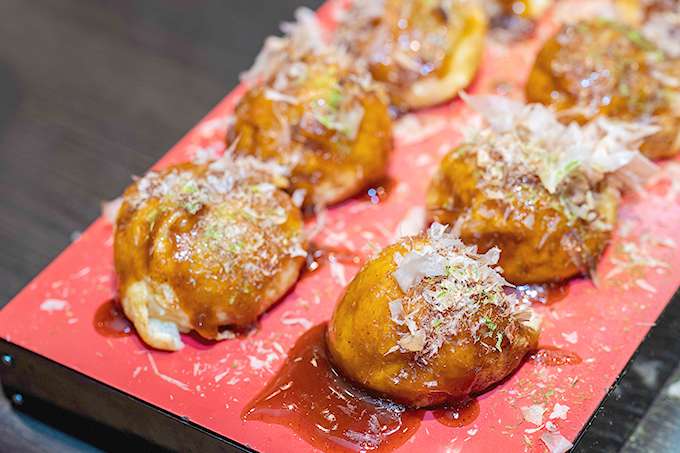
There is a related dish called akashiyaki, which originates from the city of Akashi, in the south of neighboring Hyogo Prefecture. Instead of cabbage, it is made with an egg-rich batter and dipped in dashi rather than being covered with sauce. It is often served on a distinctive square red wooden platter which you are sure to spot on your Osaka adventure.
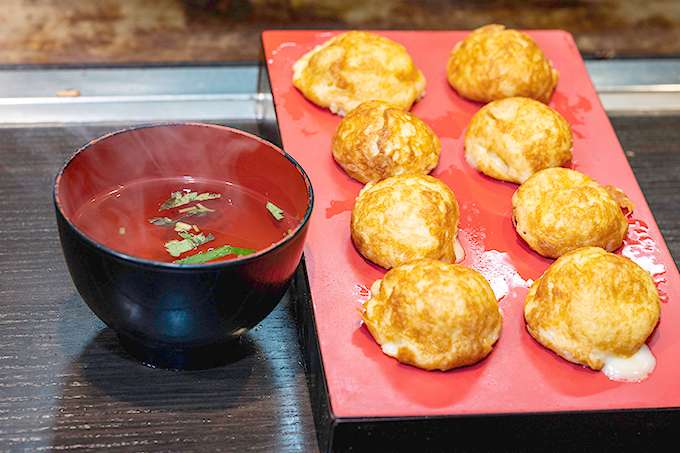
Culinary DIY
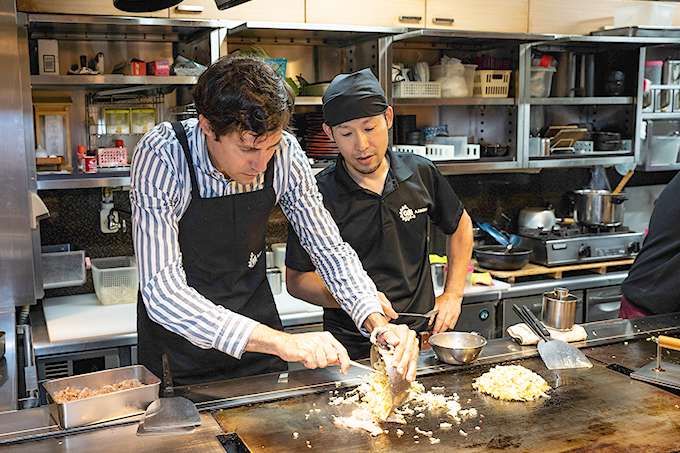
After watching the chef prepare okonomiyaki, the next step is to do it yourself! Some shops bring the mix to the table and let the customer cook their own. It’s also a great dish to try back home. You can easily pick up key ingredients in Japan or, likely, find them in the Asian section of a specialty foods store in your country. The best thing about playing chef is that you get to balance the ingredients to taste. And if you want to throw in a new flavor of your own, you are more than welcome to do so! Just about anything can be turned into delicious okonomiyaki!
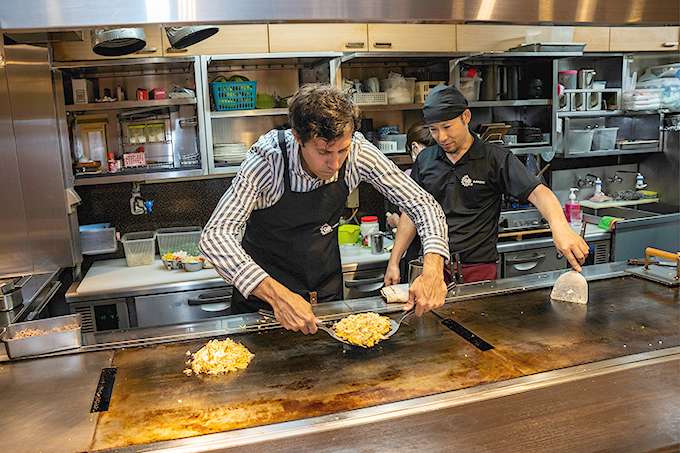
Daichi Jodoi, an expert okonomiyaki cook with over 20 years of experience, was on hand with a few pointers:
- Keep the grilling surface at a steady 180°C
- Prepare the mixture one serving at a time
- Be careful not to overcook the cabbage
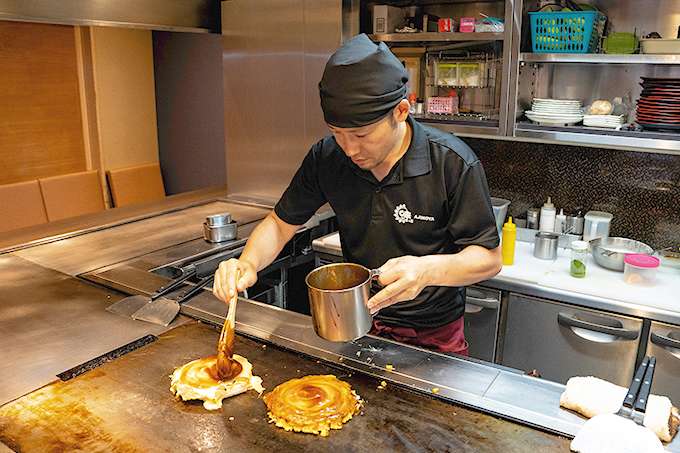
This last point is key, as cabbage is 60% water and retaining moisture is what helps maintain the fluffy texture.
Ajinoya even sells packages of their okonomiyaki and takoyaki mixes so that you can take their signature flavors home. Of course, most supermarkets also sell okonomiyaki mix and sauce, which will transport you right back to the buzz of Osaka each time you use them.
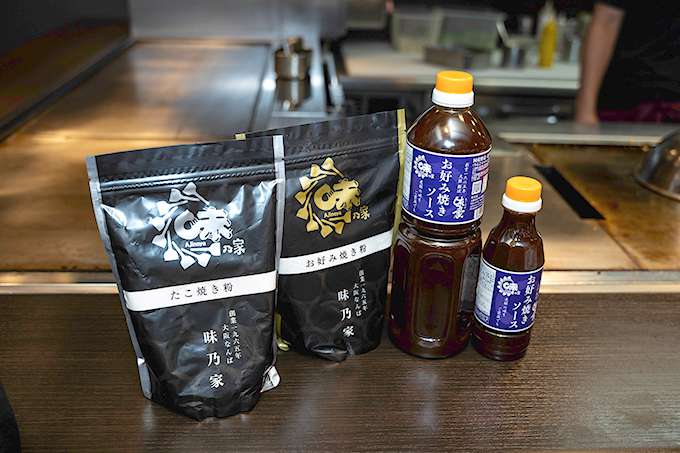
Even if you can’t find every ingredient where you live, don’t despair. Remember, okonomiyaki started off as a dish to use up leftover ingredients, so take that to heart and devise your own creations. Then, all that’s left is to do as the Osaka locals do and kuidaore—eat until you drop!
Contact Information
Ajinoya
1-7-16 Namba Chuo-ku, Osaka City, Osaka Prefecture
How to Get There
Osaka is easily accessible by Shinkansen from Tokyo and other major cities. Travelers using Kansai International Airport can catch a train to Namba Station. The trip takes about 35 minutes. Ajinoya is located within easy walking distance of the station.
Recommended Itineraries
If you have a whole day to spend in Osaka, split your time between the northern part of the city around the Umeda area before coming down to Namba to appreciate the contrast. Osaka is also an easy stop to work in on a Kansai itinerary that includes a visit to historic Kyoto and possibly the nearby port town of Kobe as well.
Related Links
Osaka Info - Dotonbori (English)
Okonomiyaki Guide (English)
Osaka (English)
Map
Featured Cuisine
Okonomiyaki is a popular dish typically made with cabbage and a batter of egg and wheat, as well as additional ingredients chosen according to personal preference. The mixture is cooked on a hot metal grill, then topped with savory sauce and, often, a combination of mayonnaise, seaweed flakes, and skipjack shavings. While the Kansai-style popularized in Osaka is the most common, Hiroshima-style okonomiyaki is another variation, in which a fried egg, as well as yakisoba or udon noodles, are added and the ingredients are layered instead of mixed.
-
Author
Author: Noam
A US-native, Noam initially thought that living in Japan would be a one-year adventure, not a life passion now spanning nearly two decades. In addition to being a freelance writer, proofreader and interpreter, he has also worked as a food guide to foreign guests in Tokyo. He's currently living and traveling across the country, taking a deeper dive into Japan's culinary culture.
All information is correct as of the time of writing.
Please check for the latest information before you travel.


















































